1/32 Decals of WWI German Printed Camouflage Fabric Five Colour ‘Lozenge’
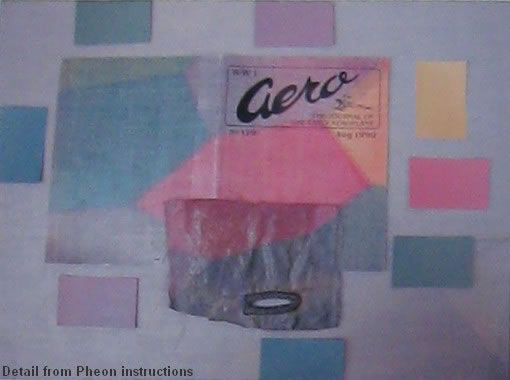
S u m m a r y : |
Catalogue No. & Price: |
D.B. Decals US$15 for two sheets
Wingnut Wings #30001 Upper, #30002 Lower, US$12.50 each, #30005 Ribtapes US$7.50
Pheon Models 32020 £19.50 Albatros DV & DVa lozenge |
Scale: |
1/32 |
Contents and Media: |
Waterslide decals, instructions and notes |
Ordering and Payment: |
Available only direct from each manufacturer
D.B Decals email: jasta32@msn.com
Wingnut Wings: http://www.wingnutwings.com/ww
Pheon Models email: pheon.models@hotmail.co.uk
Payment only by Paypal for each |
Review Type: |
First Look |
Advantages: |
All three lozenge products appear to have an excellent foundation in terms of research and accuracy |
Disadvantages: |
|
Conclusion: |
It is up to individual taste as to what colours appeal, how much guidance you feel you need and how much value you put on convenience and simplicity |
Reviewed by James Fahey

HyperScale is proudly sponsored by
Squadron.com
Now that there is a range of after-market five colour 1/32 lozenge decals from different suppliers I thought it would be useful to put them side by side and see how they look.
To introduce the comparison I would like to quote from Wingnut Wings opening paragraph in their decal instructions:
“It is unlikely that there has been a single topic more controversial amongst WWI aircraft modellers than the subject of 'the correct' colours for German lozenge camouflage decals. Many different manufacturers have produced lozenge decals in the past and will continue to do so in the future, most of which have reportedly had their colours matched to existing samples of fabric, sometimes in person but frequently through intermediaries. Yet there is a great disparity in the colours presented by the various manufacturers.”
There is no extant Idflieg report specifying what dyes the Germans used so the question of colour accuracy will probably never be settled conclusively. There are however a multitude of surviving original camouflage printed fabric (‘Flugzeugstoff’) pieces which have been studied. This doesn’t provide conclusive evidence for colours either, however, because after being stored for around ninety years in a variety of conditions the fabric can become faded and the dope finish discoloured. Nevertheless it’s a key place to start.
This review covers 1/32 five colour lozenge decals from three suppliers: D.B. Decals, Wingnut Wings and Pheon Models.
D.B. Decals
Doug Baumann is the talented modeller behind D.B Decals. About 18 months ago he set out to produce a range of more accurate lozenge decals by tapping in to the opinions of a number of experts at the forum at theaerodrome.com. Doug went through an iterative process, posting digital images, receiving feedback and refining the colours until finally achieving a consensus. Initially he made the digital images available for modellers to download for free and print at home. He is also now selling decal sheets he has printed himself for modellers who don’t find it convenient to do themselves.
The decals are inkjet printed on a white decal sheet and must be clear-coated before use to prevent the ink from running. They are produced as bolt-width lengths which must be cut to shape.
[Brett: insert DB set.jpg]
In the package Doug included two sheets printed on ordinary paper to use as pattern makers for angled fabric on the wings or inside the fuselage. Instructions with the decals are minimal and there is no guidance on historical application, the assumption being perhaps that this is readily available elsewhere.
I should point out that Doug offers three different colour options for the lower five colour lozenge: one based on the original Albatros DV in Australia, one based on fabric featured in an article in WWI Aero magazine, and another variant called ‘HAN's’. The one I am reviewing is the 'WWI Aero' option.
To my eye the colours are not completely solid or uniform but have a ‘fabric appearance’ which, although probably not in scale, provides a desirable effect.
Note the price includes free postage worldwide.
Wingnut Wings
Wingnut Wings first produced five colour lozenge decals for their LVG C.VI kit and then recently released the lozenge decals as separate items. The design has been subtly improved since they first came out with the LVG and the ‘pixellated’ appearance of some of the colours has been reduced. These decals are also in bolt-width lengths which must be cut to length.
The lozenge decal sets come with a well illustrated instruction sheet in the same style as their kit instructions, including period photos of lozenge covered aircraft.
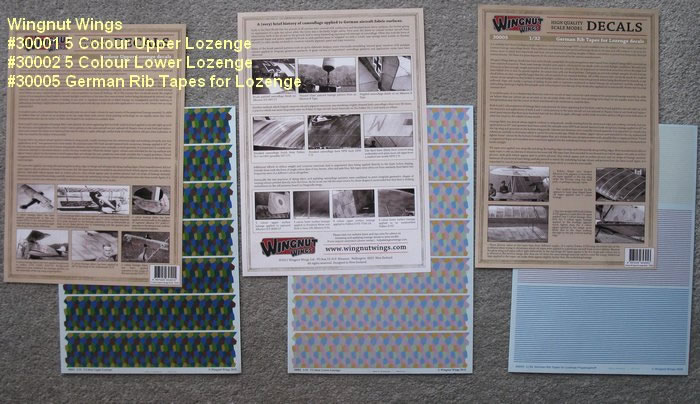
As part of their research Wingnut Wings staff personally examined original lozenge fabric material and colour-matched their decals under natural daylight conditions. According to the instructions their sample material came from undoped and un-faded dyed areas from where the edges had been folded over to sew the panels together. Working with their decal printers, Cartograf, multiple samples of each lozenge decal were printed before Wingnut Wings were completely happy that the colours matched their research findings.
The decals represent factory-fresh original colours and are somewhat brighter than the other two products.
Top and bottom lozenge and rib tapes, are each sold separately and the cost includes world wide postage. One set of each totals US$32.50 and would probably give enough decals for at least two Albatros kits.
Pheon Models
Rowan Broadbent has just released 1/32 five colour lozenge decals tailored specifically for the Wingnut Wings Albatros DV/DV.a kit. The decals come as ‘cookie cutter’ shapes to fit the wings, rudder and tailplane. Rib tapes are printed in place, including leading and trailing edge tapes, and strengthening tapes around the aileron hinges and inspection panels. This will greatly reduce the time and effort required.
The decals come in two options: with blue rib tapes or with pink (note that a mixed set, say blue top tapes and pink lower tapes is not available).

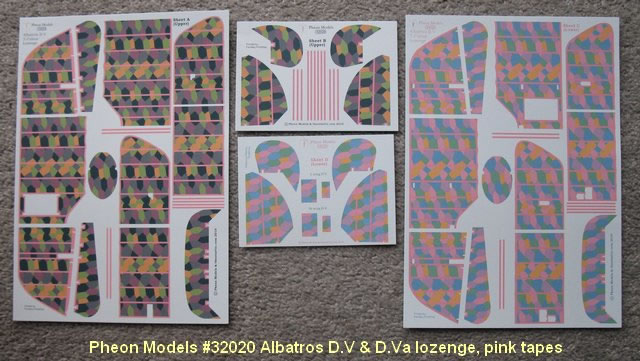
Additional tapes are provided in case modellers wish to portray the supplementary tapes sometimes seen on the lower wings. There is also a decal for the fabric covering behind the pilots seat, in both upper and lower colours.
Pheon’s lozenge decals have been developed in collaboration with Richard Andrews and Harry Green from theaviattic.com, who provided the historical research and undertook the colour matching to surviving fabric samples. The decals are printed by Fantasy Printshop in the UK and are printed over a white base for improved opacity.
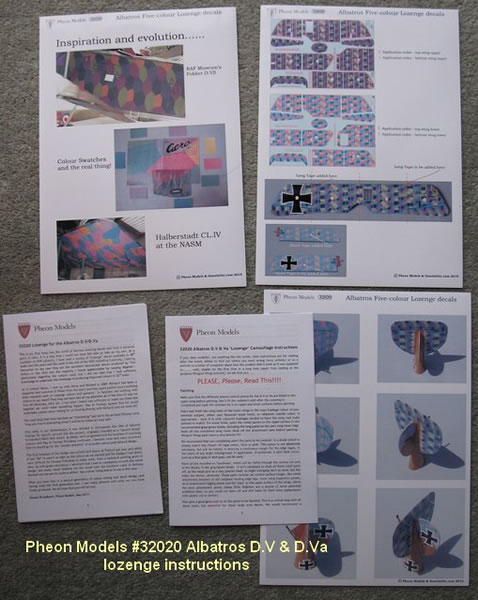
The decals come with two booklets. The first outlines the development and use of printed camouflage fabric on German aircraft in WWI, including references to useful websites, and the second provides extensive modellers notes for applying the decals. Lots of great advice here and worthy of close attention.
Pheon are working on cookie cutter lozenge sets for other aircraft including the Siemens Schuckert D.III and also four colour lozenge pattern.
The Side by Side Comparison
I photographed all the lozenge sets side by side in natural day light and then digitally cut up the image into equal sized bolt-width lengths. Note that in the case of the Pheon decals this required two decal images to be pasted together, which created a small vertical line in the image.
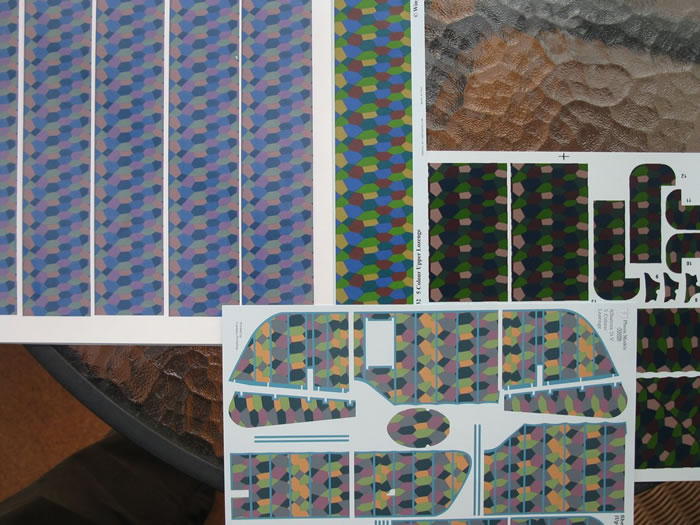
Out of interest I included Roden’s five colour lozenge decals from their Siemens Schuckert D.III kit – these decals have received unfavourable comments both for ease of use and colouring, and are best replaced.
Upper comparison:

Lower comparison:

Next I compared the pink and blue ribtapes from Wingnut Wings with the Pheon Models tapes:

The blue tapes a similar. Pheon's pink is substantially brighter than Wingnut Wings'.
Other 1/32 Lozenge Decals
I am aware of another 1/32 lozenge decal product from Techmod but I do not have a sample. Images of Techmod’s 5 colour lozenge viewed online suggest the colours are quite different to the products in this review.
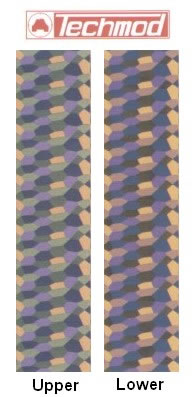
Achieving a Realistic Fabric Appearance
Large areas of uniform colour or regularly repeating patterns e.g. lozenge fabric, can look toy-like on a model. A more realistic fabric effect can be achieved using any of a variety of techniques including chalks or pastels, washes, filters or texture decals.
Wingnut Wings and Pheon both suggest further treatments if you are trying to represent weathered or faded lozenge. Wingnut Wings recommend carefully washing or airbrushing (misting) a highly thinned pale sand coloured paint over the top of the decals after application to your model. Always test on scrap material first!
Another quote from the Wingnut Wings lozenge instructions is particularly relevant at this point:
“It would be naive of us to believe that there was only ever one set of exact colours for each version of the preprinted lozenge material. So while we believe that our colours are as accurate as we can make them with current decal printing technology we are equally aware that other interpretations may also be correct as there were bound to be variations in available dyes.”
All three lozenge products appear to have an excellent foundation in terms of research and accuracy. The choice is up to individual taste depending on what colours appeal, how much guidance you would like and how much value you put on convenience and simplicity.
Thanks to Wingnut Wings and Pheon Models for the review samples. I purchased Doug Baumann’s lozenge decals.
Text and Images Copyright © 2011 by James Fahey
Page Created 14 July, 2011
Last updated
15 July, 2011
Back to HyperScale Main Page

|
